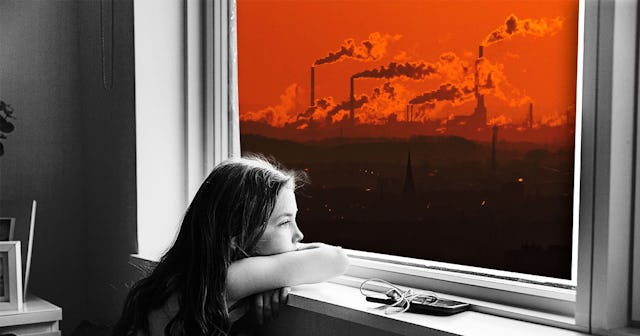Climate Change Is Robbing Our Kids Of The Carefree Childhoods We Knew

I grew up in the late ’80s and early ’90s. When school let out for summer, unless it rained, my brother and sister and I were outside. In the mornings, we rode bikes. In the afternoon, we played hide and seek with our neighbors unless a friend invited us to the town pool. At night, we caught fireflies (I knew them as lightning bugs) with our cousins. (In between, we argued, we complained, and we drove our mom bonkers, which isn’t relevant to my point, but seems important to add for full disclosure.)
We didn’t think about heat waves or air quality index. We woke up and as long as it wasn’t raining, we went outside. Often, my mom shooed us out the door with a quick “go outside” the minute we even skated around the word “bored.”
But, that’s changing. The days of saying “go outside” to kids as a safe, easy, available option for combating summer boredom are coming to an end. Due to climate change, kids often can’t just go outside.
Wildfires, floods, extreme heat, hurricanes, poor air quality are all driving kids indoors, and changing the way kids experience childhood forever.
Wildfires Impact Air Quality Forcing Kids Indoors
A couple of weeks ago in mid-July, the sun in New York City turned red. Officials issued an air quality alert. By the late afternoon, the air quality had reached a level that was “nine times above exposure recommendations from the World Health Organization.”
At that level, the EPA recommends children stay indoors. Indoors—as in, not riding bikes or playing at the park or doing the things that define childhood for many of us. (Elderly folks, those with heart or lung conditions, or those with diabetes should also stay inside.)
The cause: wildfires burning on the other side of the continent.
Wildfires, which are starting earlier and burning more acreage every year, due to climate change.
In some parts of the West, not only is the air quality forcing children indoors but recreation areas have been forced to close down due to smoke and ash. Playgrounds have become too hot to play on.
It’s Too Hot To Play Outside
Heat waves aren’t new, but they are starting earlier and ending later. According to the EPA, heat waves seasons last almost two months longer than they did just fifty years ago. Which means parents can’t just send their kids outside for the day anymore and expect the worst thing to happen is a few scraped knees.
Kids are more susceptible to heat than adults. They breathe at a higher rate and become dehydrated faster than adults.
In the past, many kids looking to beat the heat could escape to a pool. As climate change continues to upend summer as we once knew it, that might not be the case. Pools might be forced to closed for periods of time. That’s already happened in some places. In Portland, Oregon, some pools were forced to close when temperatures spiked above 110 degrees. The Parks and Recreation agency explained that it was too hot for employees and guests to be outside.
Likewise, pools in Florida were forced to close when hurricane Elsa—the earliest “E” storm on record—came through.
If you’re thinking, kids can just hit the beach. Well—maybe not. The beaches aren’t free from the effects of climate change. Rising sea levels are causing some beaches to disappear and others to be inaccessible.
With no pools or beaches, kids looking to beat the heat are once again finding themselves indoors.
Samuel Corum/Getty
Summer Outdoor Camps Are Impacted
Climate change is coming for summer camps, as well. A camp in Washington was forced to delay its start due to the heat dome in the Pacific Northwest that caused record breaking temperatures. Another camp in Colorado has been forced to evacuate twice in the past five years due to wildfires. A high school football camp in Arizona was forced to move inside after a streak of 115-degree days.
Camps in general are experiencing longer heat waves and the need for more indoor, or air conditioned, activities.
“The reality is yes, they are having more high-temperature days, and generally more heat waves, and other impacts, as well,” Donald J. Wuebbles, a professor in the Department of Atmospheric Sciences at the University of Illinois told the New York Times in regard to summer camp. “When we do get rainfall it’s more likely to be a bigger rainfall and when we get a drought it’s more likely to be a bigger drought.”
Fireflies Are Endangered
Childhood will look different even in the evening, when presumably the temperature has cooled down enough to allow kids to emerge from their air-conditioned shelters. Many of us spent summers catching fireflies. But now, fireflies may be heading toward extinction. Granted that’s not because of climate change per se—it’s more a function of urbanization and light pollution— but it’s another way that childhood will be fundamentally changed.
The scary thing is—things are likely only going to get worse. A recent New York Times article posed the question: Is This The End Of Summer As We’ve Known It? The answer is probably yes. A 2019 report found that by mid-century the United States will experience twice as many days with a heat index above 100°F and four times as many days with an index above 105°F.
Time outside is critical for children. Outdoor green space can improve kids’ health—both physical and emotional. After a year of being stuck inside due to COVID, kids need time to be kids more than ever. Unfortunately, climate change is making that difficult or impossible. It’s redefining childhood in a way that’s unspeakably sad. In a way that’s impacting our kids in ways we can see and ways we can’t.